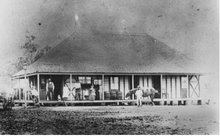Yesterday my children came back from school bearing a handful of literature from Hamish. Who is Hamish and what has he to do with the education of my children? Hamish is apparently the friendly face of educating locals about Equine Influenza, which has swept across southeast Queensland. Hamish asks important questions like:
1. Equine influenza is a sickness that:
a) people can catch
b) horses catch, but not people,
c) dogs and cats catch.
2. If I see a horse on my way to or from school, should I pat it?
3. What should I do if I am looking after a horse that has equine influenza and my personal favourite, “While equine influenza is around it’s: a) a good idea to move horses any time, b) against the law to move horses, c) OK to move horses on Tuesdays.”
While we don’t have horses, we have seen the effects of this previously foreign disease sweep across the Scrub. One of the initial outbreaks was in Warwick quickly followed by Minden, Rosewood and Marburg. Marburg has been the site of some of the only deaths from EI in Queensland. The most noticeable thing for us has been the disappearance of horse movement. In the course of an average day people ride horses along our road, neighbours move horses in trailers, local trainers take their horses along the main road to the showground and the showground is busy with training runs and the Sunday race meeting. All this has ceased until further notice.
Hamish’s quiz was accompanied by various horse-related puzzles and a thick sheaf of instructions for measures to prevent spread of EI. I was amazed by the complexity of implementing these. Perhaps this explains the rapid spread of the disease. I suspect many horse owners just can’t see the point of trying to avoid the disease, much along the line of parents who deliberately expose their children to childhood diseases in order to “just get it over with.” The problem as far it is has been explained to me is that once this disease gets a foothold, it becomes a permanent problem that continues to flare at intervals causing distress to the horses and financial hardship to their owners. Already many horse related businesses are in financial difficulty as are horse breeders and racers.
Perhaps one of the more disturbing instructions was that people who have horses and children attending school should make sure that their children disinfect and shower before going to school and on their return, because the disease can be passed via clothing, skin and footwear person to person for up to three days. Realistically this can’t be happening.
Australia has always been vulnerable to the invasion of previously unknown organisms. From earliest times quarantine has been a feature of migration and Australians are accustomed to stringent customs and quarantine requirements for travelling. The Jaeckels would have had to wait offshore for several weeks on arrival in Australia and landed at an offshore quarantine station if there were visible signs of disease among passengers and crew. Nonetheless there is a history of imported diseases and organisms sweeping across the country.
I was amazed the first time I went to the United States and we were permitted to bring in unpackaged foodstuffs, honey and fruit. Australians have been accused of using their customs and quarantine regulations to circumvent free trade requirements, but it is valid for us to argue that we have an unique environment, perched at this end of the globe, that is vulnerable and in need of protection. The failure of quarantine that led to this outbreak illustrates this vulnerability. And now small communities in Queensland are affected in concrete and material ways.
Wednesday, 17 October 2007
Subscribe to:
Post Comments (Atom)

No comments:
Post a Comment